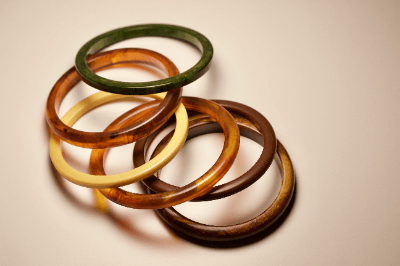What Is a Phenolic Resin?

Phenolic resins have excellent heat resistance, chemical resistance, and insulation properties and are used in a wide range of applications, such as automobiles, electronic components, and insulation materials. Phenolic resins are obtained through polymerization reactions using phenols and aldehydes as raw materials. Their physical properties can be changed by changing the chemical structures of the phenols and aldehydes used as raw materials and additives added to the resin and other factors.
Phenolic resins are classified into two types with different chemical structures: the novolac type obtained by acid catalyst reaction and the resol type obtained by base catalyst reaction. In the former, a curing reaction occurs when mixed with a curing agent such as epoxy resin and heated, while in the latter, a curing reaction occurs only by heating without a curing agent. Other differences include thermoplasticity in the novolac type and thermosetting in the resol type.
Uses of Phenolic Resins
Phenolic resin is the world’s first man-made plastic, invented by Bakelite in 1907. It has excellent heat resistance, chemical resistance, insulation, and mechanical strength and is still used in many industries. For example, phenolic resins are used in high-temperature process parts, such as resins for automobile brakes and the steel and glass industries. They are also used in insulation materials for housing and resins for photoresists.
Phenolic resins can change their physical properties by changing the chemical structure of the resins by changing the structure of phenols and aldehydes used as raw materials and by changing additives such as fillers. Therefore, selecting the optimal phenolic resin according to the required properties is necessary.
Types of Phenolic Resins
Phenolic resins obtained by reacting phenols with aldehydes include “novolac type” and “resol type”. Novolac-type resins are obtained by reaction under an acid catalyst and are reusable thermoplastic resins. On the other hand, the result type is a non-reusable thermosetting resin obtained by using a base catalyst.
Novolac resins are cured by heating with a curing agent such as epoxy resin, resulting in a high molecular weight resin. On the other hand, in the case of the resol type, the curing reaction proceeds by heating or acid even in the absence of a curing agent. Therefore, resol resins may also change over time during storage, resulting in higher molecular weight.
Synthesis of Phenolic Resins
Phenolic resins are obtained by the addition-condensation of phenols and aldehydes. The reaction of phenol and formaldehyde is introduced here as a typical example.
As mentioned above, the compounds obtained differ between acid and base catalysts. With an acid catalyst, an electrophilic substitution reaction occurs at the ortho or para position of the OH group of phenol, which reacts with formaldehyde. After the reaction, a condensation reaction occurs with another phenol to obtain a novolac resin.
On the other hand, when a base catalyst is used, multiple formaldehyde reacts with the benzene ring of phenol to produce an oily mixture called resol. When this is heated, the resolves react with each other to form a thermosetting resin called resin.
In this way, when acid and base catalysts are used, the bonding sites and amounts of phenols and aldehydes that react are different, and the structure and physical properties of the phenolic resin obtained are also different.
Disadvantages and Cautions of Phenolic Resins
While phenolic resins have various advantages, they also have some disadvantages. For example, phenolic resins undergo hydrolysis when in contact with a strong base such as sodium hydroxide in the presence of water, resulting in the degradation of the resin.
In addition, the phenolic resin itself is colored yellow or reddish brown and turns black when oxidized, so there is a limit to the range of coloring possible. Phenolic resins are also hard but brittle.